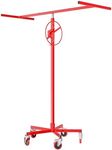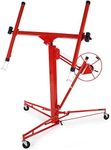Buying Guide for the Best Drywall Lifts
Choosing the right drywall lift can make your construction or renovation project much easier and more efficient. A drywall lift is a tool designed to help you lift and position drywall sheets onto walls or ceilings, reducing the physical strain and making the process safer and faster. When selecting a drywall lift, it's important to consider several key specifications to ensure you get the best fit for your needs. Understanding these specs will help you make an informed decision and choose a lift that will serve you well for your specific projects.Weight CapacityWeight capacity refers to the maximum weight the drywall lift can safely handle. This is important because drywall sheets come in different sizes and weights, and you need a lift that can support the heaviest sheets you plan to use. Typically, drywall lifts have weight capacities ranging from 100 to 200 pounds. If you are working with standard drywall sheets, a lift with a capacity of around 150 pounds should suffice. For heavier or larger sheets, look for a lift with a higher weight capacity to ensure safety and ease of use.
Lift HeightLift height is the maximum height the drywall lift can raise a sheet. This is crucial for projects involving high ceilings or walls. Drywall lifts generally offer lift heights between 11 to 15 feet. If you are working on standard residential ceilings, a lift height of around 11 feet should be adequate. For commercial projects or rooms with higher ceilings, you may need a lift that can reach up to 15 feet. Consider the height of the areas you will be working in to determine the appropriate lift height for your needs.
Ease of Assembly and DisassemblyEase of assembly and disassembly refers to how quickly and easily you can set up and take down the drywall lift. This is important for convenience and efficiency, especially if you need to move the lift between different job sites. Look for lifts that have simple, tool-free assembly and disassembly processes. If you frequently move between locations or have limited storage space, a lift that can be quickly taken apart and reassembled will save you time and effort.
Stability and Safety FeaturesStability and safety features are critical for ensuring the lift remains steady and secure while in use. This includes features like locking mechanisms, sturdy base designs, and anti-slip components. A stable lift reduces the risk of accidents and ensures precise placement of drywall sheets. When choosing a lift, check for features such as a wide tripod base, locking casters, and secure holding brackets. These features will provide added safety and stability, making your work easier and safer.
PortabilityPortability refers to how easily the drywall lift can be moved and transported. This is important if you need to use the lift in multiple locations or store it when not in use. Look for lifts with wheels or casters that allow for easy movement. Additionally, consider the weight of the lift itself; lighter models are easier to transport but may sacrifice some stability. If you need to move the lift frequently, choose a model that balances portability with stability and ease of use.












